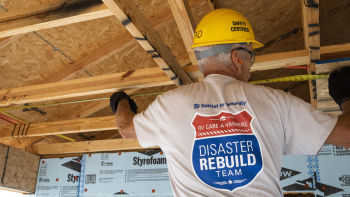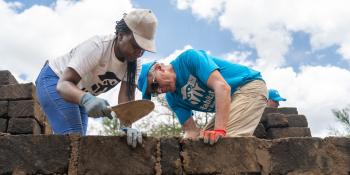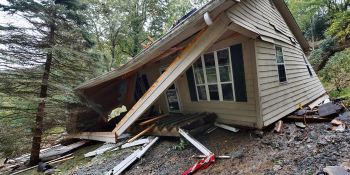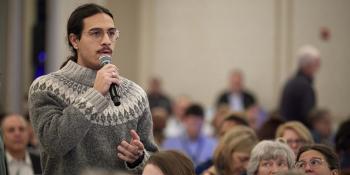People in communities around the world are facing the devastating effects of more frequent and severe disasters.
From hurricanes and wildfires to floods and tornadoes — their impact is felt most deeply by communities already facing historic disinvestment and housing inequities. These impacts are largely compounded in the U.S. by the fact that insurance rates have risen over 40% on average in the past six years — with some states seeing increases as high as 76%.
At Habitat for Humanity, we believe every community deserves not only the right to recover, but the power to thrive. That’s why we’re reimagining disaster recovery — building resilience in housing and restoring lives with dignity and justice at the center of all we do.
Rebuilding with resilience
Our disaster recovery work goes beyond emergency relief.
We help communities navigate the full cycle of disasters: from preparedness and mitigation to long-term recovery and reconstruction. Through our Pathways to Permanence approach, we work hand-in-hand with communities to deliver trauma-informed, equity-centered and community-driven solutions.
Whether it’s building wildfire-prepared homes in California, training local laborers to repair hurricane-damaged homes in Dominica or providing critical information to earthquake survivors through a weekly radio program in Nepal, we are creating safer, stronger and more financially resilient futures.
Why this matters
United States
- 95% of U.S. residents live in counties that have experienced at least one federally declared disaster in the last decade.
- Low-income communities experience greater risk in extreme weather conditions as 90% of deaths in disaster are in these communities.
- Black and Latino households face greater damage, longer recovery timelines and more barriers to federal assistance.
- Inherited property with unclear or disputed ownership often blocks families from receiving insurance payouts or disaster assistance, worsening financial hardship.
- The average cost to repair a hurricane-damaged home is $21,000 — far beyond the reach of many low-income households.
Global
- The Asia Pacific region accounts for three-quarters of people displaced by disasters, which erode development gains.
- Lack of formal property rights in Latin America and the Caribbean exclude households from accessing aid, making them more vulnerable to disasters.
- Emerging markets face financing gaps in meeting their disaster recovery needs and must take on further debt to recover.
- 46 million people were newly displaced by disaster in 2024, but they lack adequate legal protections if displaced in neighboring countries.
- By 2050, the global urban population will grow to 2.5 billion, with most of the growth expected in Asia and Africa, regions with very high climate vulnerability.
These are not just numbers. They are lived realities.
They call for a response that is as personal as it is powerful.
Stories of impact
Across the country and the world, Habitat affiliates are leading the way.
Bowling Green, Kentucky
A Habitat-built storm shelter with the ability to withstand 250 mph winds now doubles as a space for community trainings in financial literacy, home maintenance and disaster preparedness.
Puerto Rico
Habitat partnered with local groups to adapt a community center into an emergency preparedness warehouse and co-created tools like comics and online guides that teach safe construction and flood risk reduction.
Across Europe
Habitat repurposed vacant buildings, supported host families and piloted social rental programs to provide Ukrainian refugees with housing and services like childcare, language classes and job training.
These stories showcase what’s possible when recovery is done hand in hand with communities.
Get involved
Disaster recovery is about more than rebuilding — it’s about building resilience, restoring hope and securing futures.
Find out how you can get involved with Habitat and join us in creating a future where every family has the tools, support and shelter they need to not just withstand the next storm, but to thrive long after it.



